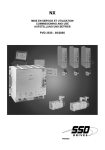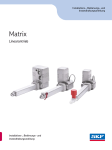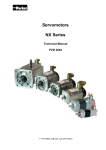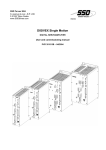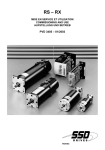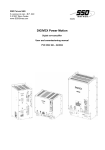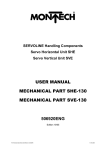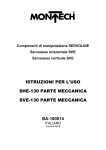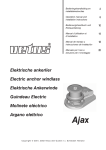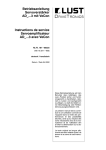Download PVD 3535
Transcript
NX MISE EN SERVICE ET UTILISATION COMMISSIONING AND USE PVD 3535E – 02/2011 Conformité aux directives « C E » Les servomoteurs NX répondent à la directive no 73/23/CEE du 19 février 1973 (modifiée par la directive no 93/68/CEE du 22 juillet 1993) et sont conformes aux normes EN 60034-1 et IEC 341/1994. Le respect de ces normes nécessite un montage des servomoteurs conformément aux recommandations de la présente notice. En outre, le montage se fera sur un support mécanique assurant une bonne conduction thermique et ne dépassant pas 40 °C à proximité de la bride moteur. Compliance with « C E »directives NX servomotors comply with Directive 73/23/CEE of 19th February 1973 (as amended by Directive 93/68/CEE of 22nd July 1993) and also meet Standards EN 60034-1 and IEC 34-1/1994. Compliance with these standards requires that the servomotors be mounted in accordance with the recommendations in this user manual. Equipment shall furthermore be mounted on a mechanical support that conducts heat effectively and does not exceed 40°C in the vicinity of the motor end plate. Date de la mise en service / Start up date : Date de livraison / Delivery date: Type de servomoteur / Servomotor type : PARKER Etablissement de Dijon 8, avenue du Lac – BP30749 F-21007 DIJON CEDEX Tel : +33 (0)3 80 42 41 40 Fax : +33 (0)3 80 42 41 23 www.parker.com NX TABLE DES MATIERES / CONTENTS NX 1. 1.1 1.2 1.3 1.4 1.5 1.6 1.7 2. 2.1 2.2 2.3 2.4 2.5 2.6 2.7 4. 4.1 5. 5.1 6. 1 MISE EN SERVICE ET UTILISATION 2 Consignes de sécurité Généralités Prescription de montage et d'utilisation Installation Raccordement électrique Restriction d’usage Aide au diagnostic 2 3 4 4 6 9 9 COMMISSIONING AND USE 10 Safety General Instructions for commissioning and use Installation Electrical connection Using restriction Troubleshooting ANNEXE 1 – APPENDIX 1 19 Raccordement Puissance / Power connection ANNEXE 2 – APPENDIX 2 19 24 Raccordement Resolver / Resolver connection ANNEXE 3 – APPENDIX 3 24 27 Caractéristiques Générales / Characteristics 7. 10 11 12 13 15 17 17 27 ANNEXE 3 – APPENDIX 3 28 Déclaration CE de conformité/EC declaration of conformity 1 PVD 3535E – 02/2011 28 NX 1. MISE EN SERVICE ET UTILISATION 1.1 Consignes de sécurité Les servoentraînements comportent deux types principaux de dangers : - Danger électrique Les servoamplificateurs peuvent comporter des pièces non isolées sous tension alternative ou continue. Avant l’installation de l’appareil, il est recommandé de protéger l’accessibilité aux pièces conductrices. Même après la mise hors tension de l’armoire électrique, la tension peut rester présente pendant plus d’une minute, le temps nécessaire à décharger les condensateurs de puisssance. Afin d’éviter le contact accidentel avec des éléments sous tension, il est nécessaire d’étudier préalablement certains aspects de l’installation : - l’accès et la protection des cosses de raccordement, - l’existence de conducteurs de protection et de mise à la terre, - l’isolation du lieu de travail (isolation des enceintes, humidité du local...). Recommmandations générales : Vérifier le circuit de protection. Verrouiller les armoires électriques. Utiliser un matériel normalisé. - Danger mécanique Les servomoteurs sont capables d’accélérer en quelques millisecondes. Afin d’éviter tout contact de l’opérateur avec des pièces en rotation, il est nécessaire de protéger celles-ci à l’aide de capots de protection. Le processus de travail doit permettre à l’opérateur de s’éloigner suffisamment de la zone dangereuse. Tous les travaux de montage et de mise en service doivent être exécutés par un personnel qualifié connaissant les règles de sécurité (par exemple : NF 18 510, VDE 0105 ou CEI 0364). - Danger de brûlure La température de la carcasse peut dépasser 100°C. 2 PVD 3535E – 02/2011 NX 1.2 Généralités 1.2.1 Description Les servomoteurs série NX sont des servomoteurs brushless à aimants permanents, adaptés à la régulation de vitesse et aux asservissements de position. Ils sont optimisés pour fournir un couple élevé et des accélérations importantes grâce à la faible inertie de leur rotor. Les applications sont multiples et comprennent la robotique, les machines spéciales, la manutention, etc. 1.2.2 Codification Un servomoteur est défini par ses caractéristiques électriques et mécaniques, par les accessoires dont il est équipé et par une éventuelle spécificité client. Ces indications sont codifiées et rappelées dans la case « Type » de la plaque de firme pour la codification de base, et dans une autre case pour la ou les spécificités. N X 3 1 0 E A K N : brushless 10 pôles 1 0 0 0 00 : arbre lisse 01 : arbre claveté 10 : protection IP65 11 : protection IP65 + arbre claveté Nombre de modules (fonction de la longueur) X : moteurs d’axe à aimants Ne Fe Bo R 0 : moteur de base 1 : moteur + PTC 2 : moteur + Thermoswitch 3 : moteur + frein 4 : moteur + frein +PTC 5 : moteur + frein +Thermoswitch Type de bobinage A : classe A E : classe F V : ventilé Taille 1 - 2 - 3 - 4 - 6 - 8 (fonction du diamètre) 1 : câbles 2 : câbles blindés 4 : fils surgainés blindés 6 : boîte à bornes 7 : connecteurs 8 : connecteurs + ventilation 9 : boîte à bornes + ventilation Capteur A : resolver 2 pôles M : codeur absolu multitours POSIVEX® R : codeur absolu monotour HIPERFACE® - 128 périodes/tour ® S : codeur absolu multitours HIPERFACE - 128 périodes/tour ® T : codeur absolu monotour HIPERFACE - 1024 périodes/tour ® U : codeur absolu multitours HIPERFACE - 1024 périodes/tour V : codeur absolu monotour ENDAT® ® W : codeur absolu multitours ENDAT X : codeur incrémental – 2048 traits/tour Bobinage Rubrique mécanique 1.2.3 Caractéristiques électriques Les caractéristiques principales sont indiquées sur les plaques signalétiques. Les caractéristiques complètes sont décrites dans la documentation commerciale. 3 PVD 3535E – 02/2011 NX 1.3 Prescription de montage et d'utilisation 1.3.1 Réception du matériel Tous les servomoteurs font l’objet d’un contrôle rigoureux en fabrication, avant l’envoi. Vérifier l’état du servomoteur en enlevant soigneusement celui-ci de son emballage ; Vérifier également que les données de la plaque signalétique sont en conformité avec celles de l’accusé de réception. En cas de détérioration du matériel pendant le transport, le destinataire doit immédiatement émettre des réserves auprès du transporteur par lettre recommandée, sous 24 h. Attention : l’emballage peut contenir des documents ou accessoires indispensables à l’utilisateur. 1.3.2 Stockage En attendant le montage, le servomoteur doit être entreposé dans un endroit sec, sans variation brutale de température pour éviter la condensation. Si le servomoteur doit être entreposé longtemps, vérifier que le bout d’arbre et la face de la bride sont bien enduits d’un produit anticorrosion. Après un stockage prolongé (plus de 3 mois), faire tourner le moteur à faible vitesse dans les deux sens, pour homogénéiser la graisse des roulements. Si le servomoteur est IP 65, mettre un peu de graisse entre le joint tournant et la bague. 1.4 Installation 1.4.1 Préparation L’installation doit permettre un accès à la connectique et la lecture de la plaque signalétique. L’air doit pouvoir circuler autour du moteur pour assurer son refroidissement. Nettoyer l’ arbre-moteur à l’aide d’un chiffon imbibé de white spirit, alcool, acétone, en veillant à ne pas introduire de produit dans le roulement. Pendant le nettoyage, le servomoteur doit être en position horizontale. La position du moteur en fonctionnement est indifférente. La surface du moteur peut atteindre des températures supérieures à 100 °C : en tenir compte. 1.4.2 Montage mécanique La durée de vie des roulements du servomoteur dépend pour une bonne part du soin apporté à cette opération. Dans le cas de servomoteur dont l’arbre comporte une clavette, s’assurer que les organes d’accouplement ont bien été équilibrés sans clavette, le servomoteur ayant été équilibré avec sa clavette. 4 PVD 3535E – 02/2011 NX Vérifier soigneusement l’alignement de l’arbre du moteur avec celui de la machine entraînée, afin d’éviter des vibrations, une rotation irrégulière ou un effort trop important sur l’arbre. Proscrire tout choc sur l’arbre et éviter les montages à la presse qui risquent de marquer les pistes des roulements. Si le montage à la presse ne peut être évité, il convient d’immobiliser l’arbre en translation, cette solution est néanmoins dangereuse par les risques qu’elle fait courir au resolver. Pour emmancher poulies ou accessoires, utiliser le filetage du bout d’arbre selon le schéma. Il est possible de venir en appui sur l’épaulement de l’arbre situé devant le roulement. Dans le cas où l’étanchéité du palier avant est réalisée par un joint à lèvre qui frotte sur la partie tournante (version IP 65), la lubrification à la graisse du joint est recommandée pour prolonger sa durée de vie. Les charges (axiale et radiale) admissibles sur l’arbre sont données dans les notices commerciales. Dans le cas d’entraînement par courroie crantée, la poulie d’entraînement doit être fixée le plus près possible de la bride. Le diamètre de la poulie est à choisir pour que l’effort radial ne dépasse pas les limites indiquées dans le catalogue. Une bonne approche de l’effort radial de la poulie est donnée habituellement par la formule suivante : Fr K M 10 3 R Fr = effort radial (N) M = couple maximal d'utilisation (N.m) R = rayon de la poulie (mm) K =1,5 avec une courroie crantée K = 2,5 avec une courroie trapézoïdale K = 3,5 avec une courroie plate La tension de la courroie ne doit jamais dépasser les valeurs indiquées par le constructeur. Cette tension peut être déterminée avec un appareil mesurant la fréquence propre en flexion de la courroie. Nous ne pouvons être tenus comme responsable d’une fatigue de l’arbre moteur par suite d’efforts excessifs sur celui-ci. Dans le cas d’une association servomoteur-réducteur, l’étanchéité au lubrifiant côté moteur doit être assurée par le réducteur. Dans le cas d’un servomoteur IP 65 associé à un réducteur comportant sa propre étanchéité, il convient d’enlever le joint dont est équipé l’arbre moteur. Dans le cas où le réducteur n’est pas de notre fourniture, vérifier que les contraintes du réducteur (conditions de montage, charges sur l’arbre moteur, etc.) sont compatibles avec le servomoteur sélectionné. Vérifier le dimensionnement du réducteur et en particulier son couple de pertes. 1.4.3 Montage thermique : conditions Le couple thermique du moteur est défini de la façon suivante : Echauffement du bobinage suivant la classe F Alimentation par un variateur de type Digivex Air pouvant circuler librement autour du moteur Montage sur une bride en aluminium circulaire elle-même fixée sur une plaque carrée en acier carrée, dimensions définies dans le tableau ci-dessous 5 PVD 3535E – 02/2011 NX NX1, NX2 NX3, NX4, NX6, NX8 Diamètre Bride aluminium 180 280 Epaisseur bride aluminium 10 12 Coté plaque acier 300 500 Epaisseur plaque acier 15 20 Le couple en rotation lente est mesuré à 100 tr/min. Une part significative de la chaleur produite par le moteur est évacuée par la bride. Si l’air ne peut pas circuler librement autour du moteur, ou si le moteur est monté sur une surface évacuant mal la chaleur (surface de petite dimension par exemple), ou si le moteur est isolé thermiquement, ou si le moteur est monté sur une surface chaude (par exemple montage sur un réducteur), il faut utiliser le moteur à un couple inférieur au couple spécifié. Utilisation du moteur à l’arrêt : En cas de maintien du couple nominal à l’arrêt ou à vitesse de rotation faible (<10 tr/min), limiter impérativement le courant à 80% de Io (courant en rotation lente) afin d’éviter une surchauffe excessive du moteur (due à la répartition inégale du courant entre les 3 phases). Protection thermique par le variateur en limitant le courant Généralement le variateur protège le moteur d’une surcharge en limitant le courant efficace à une valeur inférieure au courant en rotation lente ou au courant nominal (tout en autorisant des surcharges de courte durée). Ces courants sont définis à partir d’un essai standard (cf conditions de montage thermique). Si les conditions d’échange thermique du moteur (cf conditions de montage thermique), il est impératif de réduire les valeurs de courant en rotation lente (ou nominal) pour garantir une protection efficace du moteur par le variateur. Protection thermique par une sonde (en option) Sonde PTC : inchangée Sonde KTY : il s’agit d’une sonde dont la résistance varie en fonction de la température. Elle peut donner la température du moteur si elle est raccordée à un variateur qui a cette option. Sonde thermoswitch : il s’agit d’un contact qui s’ouvre à partir d’une certaine température et qui se referme lorsque la température diminue. En fonction des types, certains peuvent commander directement un relais ou être connecté au variateur. 1.5 Raccordement électrique Avant tout raccordement, vérifier que l’armoire électrique est hors tension. Ce branchement doit être conforme au manuel de mise en service du servoamplificateur, et les câbles choisis dans la gamme que nous proposons (ou de caractéristiques équivalentes). Choisir des câbles de section suffisante pour éviter des chutes de tension. Si la longueur de câble dépasse 25 m, le montage d’un filtre en sortie du servoamplificateur peut être nécessaire : nous consulter. 6 PVD 3535E – 02/2011 NX 1.5.1 Protection thermique (en option) La protection thermique (sonde PTC) montée dans le bobinage du servomoteur, permet à l’électronique de déclencher à 150° 5° C. L’alimentation de la sonde et le traitement du signal généré sont effectués par le DIGIVEX. La sonde PTC, appelée le plus souvent thermistance, est une résistance réalisée à partir de matériaux semi-conducteur, dont la valeur de résistance augmente de façon très importante avec la température. Cette particularité permet la détection aisée et fiable d’un seuil. La faible inertie thermique de cette sonde permet de suivre au plus près les fluctuations de température du bobinage et donc d’intervenir judicieusement. Attention: dans le cas particulier du montage d'une sonde KTY, respecter les précautions de manipulation des dispositifs sensibles aux décharges électrostatiques. 1.5.2 Option codeur Attention: dans le cas particulier d’une option codeur, respecter les précautions de manipulation de ce dispositif sensible aux décharges électrostatiques. 1.5.3 Frein de maintien à manque de courant (en option) + + 220µF 63V 24V = Dans le cas d’un servomoteur avec frein, vérifier le fonctionnement avant d’entraîner le moteur. L’alimentation du frein standard est de 24 V ± 10 %, courant continu. Le frein de maintien permet l’immobilisation sous charge du servomoteur à l’arrêt. Il n’est pas conçu pour permettre des freinages dynamiques répétés, le freinage dynamique doit être réservé au cas d’arrêt d’urgence. 220 ½W 0.1µF 63V - Attention : Respecter la polarité et la tolérance en tension, et utiliser un câble blindé. Un condensateur de 220 µF évite un décollage du frein si la tension de 24 V est perturbée par le relayage extérieur. Vérifier la valeur de la tension après le montage de ce condensateur. Le réseau RC (220 Ω, 0,1 µF) est nécessaire pour éliminer le parasitage produit par la bobine du frein. Pour réduire les temps de réponse du frein, placer le contacteur dans le circuit courant continu. Respecter le raccordement en tenant compte de la polarisation du frein. 1.5.4 Raccordement des connecteurs Les raccordements des connecteurs sont décrits en annexe : Annexe 1 : raccordement puissance Annexe 2 : raccordement resolver 7 PVD 3535E – 02/2011 NX Sens de rotation du servomoteur : En respectant le câblage préconisé, une consigne de vitesse positive sur le servoamplificateur entraîne une rotation dans le sens horaire (vu côté arbre de puissance). Les connecteurs sont orientables (270°). 1.5.5 Câbles et connecteurs de raccordement puissance Les câbles de raccordement puissance, fournis par nos soins comportent : 3 conducteurs de puissance 1 conducteur de terre 1 paire torsadée blindée pour la protection thermique. 1 paire torsadée blindée pour le frein Tension d’utilisation : Tension d’essais : Tenue aux huiles : ≤ 1000 V 3000 V très bonne Les connecteurs et les câbles puissance sont décrits en Annexe 1. 1.5.6 Câble et connecteur de raccordement resolver Câble resolver Le câble resolver doit être séparé du câble de puissance. Les câbles équipés de connecteurs peuvent être livrés par nos soins : nous consulter. Le câble est constitué de 6 fils blindés et torsadés par paire. Le blindage doit être relié à la terre coté servo amplificateur uniquement 6 x 0,24mm2 + 1 blindage par paire Le câble que nous préconisons permet d’exploiter les signaux resolver jusqu’à une distance de 50 mètres. Pour des distances supérieures : nous consulter. Raccordement du servoamplificateur : se conformer à la notice de mise en service du servoamplificateur concerné. 8 PVD 3535E – 02/2011 NX Caractéristiques typiques : Référence Couleur Tension d’essais Diamètre extérieur Rayon de courbure dynamique Tenue en flexion alternée (R = 75 mm) Tenue aux huiles Gaine extérieure : : : : : : : : 6537 P0001 rouge, marquage noir 1 500 V 7,1 ± 0,2 mm ≥ 75 mm ≥ 5 millions de cycles Très bonne Polyuréthane Les connecteurs et les câbles resolver sont décrits en Annexe 2. 1.6 Restriction d’usage En cas de maintien du couple nominal à l’arrêt ou à vitesse de rotation faible (< 10 tr/min), limiter impérativement le courant à 80% de Io (courant permanent en rotation lente) afin d’éviter une surchauffe excessive du moteur. 1.7 Aide au diagnostic Les servomoteurs brushless PARVEX n’ont pas besoin de maintenance préventive. Les roulements sont à double protection et graissés à vie. Nous indiquons ci-dessous quelques symptômes avec des causes possibles. Cette liste n’étant pas exhaustive, il convient donc, dans tous les cas d’anomalies de fonctionnement, de se référer à la notice de mise en service du servoamplificateur associé (les indications de l’afficheur diagnostic vous aidera dans vos recherches). Vous constatez que le moteur ne tourne pas à la main : Vous avez des difficultés à faire démarrer le moteur ou à le faire tourner: Vérifiez qu’il n’y a pas de blocage mécanique ou de grippage. Vérifiez l’alimentation du frein. Vérifier l’alimentation du frein (+ 24 V ± 10 %) et sa polarité. Contrôlez la protection thermique éventuelle. Vérifiez l’isolement du servomoteur (en cas de doute, effectuez la mesure à froid et à chaud). La valeur minimale de la résistance d’isolement mesurée sous 50VDC maxi est de 50 MΩ : - Entre la phase et la carcasse - Entre le protecteur thermique et la carcasse - Entre le bobinage du frein et la carcasse - Entre les bobinages du resolver et la carcasse. 9 PVD 3535E – 02/2011 NX Vous découvrez que le moteur dérive : Réglez l’offset du servoamplificateur. Vous vous apercevez que le moteur s’emballe : Vérifiez la consigne de vitesse du servoamplificateur. Vérifiez que vous n’êtes pas en régulation de couple au lieu de régulation de vitesse. Vous décelez des vibrations : Vérifiez les liaisons du resolver, les liaisons de masse, la mise à la terre, le réglage de la boucle de vitesse du servoamplificateur, et le blindage. Contrôlez la stabilité des tensions auxiliaires. Vous jugez que le moteur chauffe anormalement : Vous trouvez le moteur trop bruyant : Différentes raisons possibles : - Équilibrage mécanique non satisfaisant - Le frein frotte : grippage mécanique - Accouplement défectueux - Desserrage de différentes pièces - Réglage mal adapté du servoamplificateur ou de la boucle de position : contrôlez la rotation en boucle ouverte. Il peut être trop chargé ou la vitesse de rotation est trop faible : vérifiez le courant et le cycle de fonctionnement du servomoteur. Les frottements de la machine peuvent être trop importants : - Testez le courant au moteur, en charge et à vide. - Vérifiez que le moteur ne soit pas isolé thermiquement. - Vérifiez que le frein ne frotte pas lorsqu’il est alimenté. - Assurez-vous du bon fonctionnement de la ventilation (lorsque le servomoteur en est pourvu). 2. COMMISSIONING AND USE 2.1 Safety Servodrives present two main types of hazard : - Electrical hazard Servoamplifiers may contain non-insulated live AC or DC components. Users are advised to guard against access to live parts before installing the equipment. Even after the electrical panel is de-energized, voltages may be present for more than a minute, until the power capacitors have had time to discharge. 10 PVD 3535E – 02/2011 NX Specific features of the installation need to be studied to prevent any accidental contact with live components : - Connector lug protection ; - Correctly fitted protection and earthing features ; - Workplace insulation (enclosure insulation humidity, etc.). General recommendations : Check the bonding circuit; Lock the electrical cabinets; Use standardised equipment. - Mechanical hazard Servomotors can accelerate in milliseconds. Moving parts must be screened off to prevent operators coming into contact with them. The working procedure must allow the operator to keep well clear of the danger area. All assembly and commissioning work must be done by qualified personnel who are familiar with the safety regulations (C18510 authorization, standard VDE 0105 or IEC 0364). - Burning hazard The frame temperature can exceed 100°C. 2.2 General 2.2.1 Description NX series servomotors are brushless servomotors with permanent magnets, designed for speed and position control. These servomotors are optimized to give high torque and fast acceleration thanks to the low rotor inertia. NX servomotors have many applications including robotics, special machines, handling, etc. 2.2.2 Codification Servomotors are defined by their electrical and mechanical characteristics, the accessories they are fitted with and any special customer features. These data are codified on the nameplate for basic codification and in another box for special features. 11 PVD 3535E – 02/2011 NX N X 3 1 0 E A K N : brushless 10 poles 1 0 0 0 00 : smooth shaft 01 : shaft with key 10 : protection IP65 11 : protection IP65 + shaft with key Number of modules (depends on length) X : axis motors with Ne Fe Bo magnets R 0 : standard motor 1 : motor + PTC 2 : motor + Thermoswitch 3 : motor + brake 4 : motor + brake + PTC 5 : motor + brake + Thermoswitch Type of winding A : class A E : class F V : ventilation Size 1 - 2 - 3 - 4 - 6 - 8 (depends on diameter) 1 : cables 2 : shielded cables 4 : shielded wires 6 : terminal box 7 : connectors 8 : connectors + ventilation 9 : terminal box + ventilation Sensor A : 2 poles resolver M : POSIVEX® multiturn absolute encoder R : HIPERFACE® singleturn absolute encoder - 128 periods/revolution ® S : HIPERFACE multiturn absolute encoder - 128 periods/revolution T : HIPERFACE® singleturn absolute encoder - 1024 periods/revolution U : HIPERFACE® multiturn absolute encoder - 1024 periods/revolution V : ENDAT® singleturn absolute encoder ® W : ENDAT multiturn absolute encoder X : incremental encoder – 2048 lines/revolution Winding Mechanical heading 2.2.3 Electrical features The main features are indicated on identification plates. The features are described in full in the commercial documentation. 2.3 Instructions for commissioning and use 2.3.1 Equipment delivery All servomotors undergo a thorough quality control procedure before dispatch :. Check the condition of the servomotor by carefully removing it from its packaging ; Check that the information on the identification plate corresponds to your order. Check also the accessories included in the box. If the equipment has been damaged in transit, the recipient should immediately complain to the carrier by registered letter within 24 hours. 2.3.2 Storage Before installation, the servomotor should be stored in a dry place without large temperature variations in order to prevent condensation. 12 PVD 3535E – 02/2011 NX If it is to be stored for a long time, check that the end of the shaft and the face of the flange are always coated with an anti-corrosion product. After lengthy storage (more than 3 months) rotate the motor at low speed in the both directions to ensure even lubrication of the bearings. For IP 65 servomotors add a little grease between the turning washer and the ring. 2.4 Installation 2.4.1 Preparation The installation must allow access to network engineering and it must be possible to read the identification plate. Air must be able to circulate freely around the motor for cooling. For optimum service life, motors should be protected from liquids and dust. Clean the drive shaft using a cloth soaked in white spirit, alcohol or acetone, ensuring that no liquid enters the bearings. The servomotor should be in a horizonta position during cleaning. The servomotor position doesn’t matter. The servomotor surface can reach temperatures of more than 100°C : act accordingly. 2.4.2 Mechanical installation The service life of the servomotor bearings depends largely on the care exercised during this operation. Ensure that the coupling devices are well balanced without a key, as the servomotor has been balanced with the whole key (in the case of servomotors with a key). Check carefully the drive shaft alignment with that of the driven machine in order to prevent vibration, irregular movement or too high loads on the shaft. Avoid any impact on the shaft, mountings or machining on the shaft (holes, miling, etc.) which could destroy the bearings. If press mounting is the only solution, the shaft must not turn while mounting. Use the shaft end thread for fitting pulleys or accessories as in the diagram. May rest against the shaft shoulder located in front of the bearing. Where the front bearing is sealed by a lip seal that rubs on the rotating part (IP 65 version), it is recommended to lubricate the seal for extended service life. Permissible (axial and radial) loads on the shaft are given in the commercial documentation. If the motor is driven by a timing belt, the drive pulley should be located as close as possible to the flange. The pulley diameter should be such that the radial force does not exceed the limits given in the catalogue. The following formula provides a good approximation to the radial force of the pulley : 13 PVD 3535E – 02/2011 NX Fr K M 10 3 R Fr = radial force (N) M = maximum torque during use (Nm) R = pulley radius (mm) K = 1.5 with a timing belt K = 2.5 with a V belt K = 3.5 with a flat belt The belt tension must never exceed the values specified by the manufacturer. Tension can be determined with a device for measuring the natural belt frequency in deflection. We cannot be held liable for any drive shaft fatigue ensuing from excessive strain on the shaft. Where a servomotor is combined with gearbox, the gearbox must ensure the motor is sealed against lubricant. If a IP 65 servomotor is associated with a gearbox which has its own seal, you must remove the seal on the motorshaft. If the gearbox is not provided by us, check the gearbox stresses (installation conditions, drive shaft loads, etc.) are compatible with the servomotor selected. Check the gearbox calculation and in particular its friction torque. 2.4.3 Thermal mounting conditions The motor thermal torque is defined in the following way: Winding temperature rise according to class F Motor supplied by a drive like Digivex Air able to move freely around the motor The motor is fitted on an circular aluminium flange, that is bolted on a square steel plate NX1, NX2 NX3, NX4, NX6, NX8 Aluminium flange diameter 180 280 Aluminium flange thickness 10 12 Length of the steel plate 300 500 Thickness of the steel plate 15 20 The low speed torque is measured at 100rpm An important part of the heat produced by the motor is removed through the front flange. If the air is not able to move freely around the motor, or if the motor is mounted on surface unable to dissipate efficiently the heat (small surface as an example…) or if the motor is thermally insulated or if the motor is fitted on a warm surface (on a gear box for example…), the motor must be used at a lower torque than the specified one. Motor use at standstill : In case of maintenance of nominal torque at the stop or speed low (<10 rpm), limit the current to 80% of Io (current in slow rotation) to avoid excessive overheating engine (due to an unequal current through the 3 phases). 14 PVD 3535E – 02/2011 NX Motor thermal protection through the drive by limiting the current In general, the drive protects the motor against an overload by limiting the rms current to a value lower than the low speed current or the nominal current (but it allows short time overload). These currents are defined by a standard test (cf: thermal mounting conditions) If the thermal conditions are not good (cf: thermal mounting conditions) the current limitations must be reduced at a lower value than the standard one, to make sure than the thermal protection of the motor through the drive is effective. Thermal protection by sensor (option) PTC sensor: unchanged KTY sensor: it is a resistance that changes with the temperature. If it is connected to a suitable drive, it can measure the temperature of the motor. Thermoswitch sensor: it is a switch that is on when the temperature is too high. Some can drive directly a relay or can be connected to the drive. 2.5 Electrical connection Before making any connections, make sure power to the electrical cabinet is off. This connection must comply with the servoamplifier installation manual, and the cables selected from the range we offer (or equivalent characteristics). Choose cables with a cross-section large enough to prevent voltage drops. If the cable is more than 25 m long, a filter may be required at the servoamplifier output : ask us for details. 2.5.1 Thermal protection (as an option) A thermal protector (PTC sensor) fitted in the servomotor winding trips the electronic system at 150° 5° C. The DIGIVEX. supplies the sensor and processes the signal generated. The PTC sensor, usually known as a thermistor, is a resistor made from semi-conductor material whose resistance increases substantially with temperature. This means a limit can be easily and reliably detected. The low thermal inertia of the sensor means winding temperature variations can be monitored very closely and action taken as required. Caution: the precautionary measures for handling devices sensitive to electrostatic discharges should be observed in the specific case of fitting a KTY sensor. 2.5.2 Encoder option Caution: the precautionary measures for handling device sensitive to electrostatic discharges should be observed in the specific case of an encoder option. 15 PVD 3535E – 02/2011 NX 2.5.3 Holding brake energize to release (as an option) + + 220µF 63V 24V = - In a servomotor with brake, check that it works before running the motor. The standard brake has a 24 V ± 10 % DC supply. Servomotor brakes should not be used to stop the motor but to immobilize it in rotation when it is stationary. The holding brake is used for many repetitive dynamic brakings but the dynamic braking is only reserved for emergency stop. 220 ½W 0.1µF 63V Warning : Observe the polarity and tolerance under tension and use a shielded cable. A capacitor of 220 µF prevents the brake disengaging if the 24 V voltage is disrupted by external relaying. Check the voltage value after fitting their capacitor. To reduce brake response time, fit the contactor into the dc circuit. Wire with regard to brake polarisation. 2.5.4 Connecting The connections are described in the appendix: - appendix 1 : power connection appendix 2 : resolver connection Rotation direction of the servomotor : In consideration with the recommended connection, a positive speed input on the servoamplifier is followed by a rotation in the clockwise direction (seen from power shaft side). The connectors are adjustable (270°). 2.5.5 Power connection cables and connectors The power connection cables we provide include : 3 power conductors 1 earth conductor 1 shielded twisted pair for thermal protection. 1 shielded twisted pair for the brake. Service voltage Test voltage Oil resistance : : : 16 ≤ 1000 V 3000 V very good PVD 3535E – 02/2011 NX The connector plugs and power cables are described in the Appendix 1. 2.5.6 Cable and connector for resolver connexion resolver Cable The resolver cable must be separated from the power cable. Cables fitted with connectors may be provided by us : ask for details. The cable is made up of 6 wires twisted and shielded in pair. The shielding must be earthed on the servoamplifier side only 6 x 0,24mm2 + 1 shielding per pair The recommended cable can use resolver signals from up to 50 m away. For greater distances ask for details. Servoamplifier connection : comply with the relevant servoamplifier installation instructions. Typical characteristics: Reference Colour Test voltage Outside diameter Dynamic radius of curvature Alternating bending strength (R = 75 mm) Oil resistance External sheath : : : : : : : : 6537 P0001 red, black markings 1 500 V 7,1 ± 0,2 mm ≥ 75 mm ≥ 5 million cycles Very good Polyurethane The connector plugs and resolver cables are described in the appendix 2. 2.6 Using restriction If the nominal torque is hold in the stopped position or at very low speed (< 10 rpm), the torque should be limited to 80% of Io (permanent current at low speed) to avoid an excessive overheating of the motor. 2.7 Troubleshooting Brushless servomotors PARVEX don’t need preventive maintenance. The bearings have a double protection and are life-greased. 17 PVD 3535E – 02/2011 NX Certain symptoms and their possible causes are listed below. This list is not comprehensive. Whenever an operating incident occurs, consult the relevant servoamplifier installation instructions (the troubleshooting display indications will help you in your investigation). You note that the motor Check the electricity supply to the brake. does not turn by hand Check there is no mechanical blockage or seizing. You have difficulty starting the motor or making it run You find that the motor is drifting You notice that the motor is racing Adjust the offset of the servoamplifier. Check the speed set-point of the servoamplifier. Check you are well in speed regulation (and not in torque regulation). You notice vibrations Check the encoder and tachometer connections, the earth connections (carrefully) and the earthing of the earth wire, the setting of the servoamplifier speed loop, tachometer screening and filtering. Check the stability of the secondary voltages. Check the electricity supply to the brake (+ 24 V, ± 10 %) and its polarity. Check the eventual thermal protection. Check the servomotor insulation (if in doubt, measure when hot and when cold). The minimum insulation resistance measured at 50 VDC max is 50 MΩ: - Between the phase wire and the casing - Between the thermal protector and the casing - Between the brake winding and the casing - Between the resolver windings and the casing. You think the motor is becoming unusually hot You find that the motor is too noisy Several possible explanations : Unsatisfactory mechanical balancing The brake rubs (mechanical seizing) Defective coupling Loosening of several pieces Poor adjustment of the servoamplifier or the position loop : check rotation with the loop open. It may be overloaded or the rotation speed is too low : check the current and the operating cycle of the servomotor. Friction in the machine may be too high : test the motor current with and without a load : - Check the motor doesn’t have thermal insulation. - Check the brake doesn’t rub when it is energized. - Check the good functioning of the ventilation if the servomotor has one. 18 PVD 3535E – 02/2011 NX 3. ANNEXE 1 – APPENDIX 1 3.1 Raccordement Puissance / Power connection 3.1.1 Connecteur de Puissance / Socket Power connector NX2 – NX3 – NX4 – NX6 – NX8 F Vue suivant F F View Abbildung gemäß F FONCTION FUNCTION FUNKTION BROCHAGE FICHE PLUG PINS KONTAKTBELEGUNG STECKER FREIN +* BRAKE +* BREMSE +* A Vert-rouge Green-red grün-rot FREIN -* BRAKE -* BREMSE -* B Vert-bleu Green-blue grün-blau PROT. THERMIQUE* THERMAL PROTECTION * THERMOSCHUTZ* C Orange / Orange / orange D Jaune / Yellow / gelb TERRE / EARTH / ERDE 2 Jaune-vert / Yellow-Green gelb-grün U V W 1 4 3 Noir / Black / schwarz Blanc / White / weiß Rouge / Red / rot * Optionnel * Optional * Optionale 19 PVD 3535E – 02/2011 COULEUR COLOR FARBE NX Références des connecteurs et câbles Puissance – Power Cable and connector references – Bestellnummern der Steckverbinder und Leistungskabel Intensité permanente maximale Max. continuous rating Max. Dauerstrom Fiche puissance modèle renforcé Heavy-duty power plug Leistungssteckverbinder in verstäker Ausführung Câble polyuréthane au mètre Polyurethane cable per metre Polyurethankabel meterweise 8Â 220065R1610 6537P0009 32 Â 220065R1611 6537P0010 (≤50 m, 30°C) Variateur – Drive – Verstärker : DIGIVEX Intensité permanente maximale Max. continuous rating Max. Dauerstrom (≤50 m, 30°C) Câble polyuréthane équipé avec fiche au mètre Plug fitted Polyurethane cable per metre Konfektioniertes Polyurethankabel mit Stecker meterweise (xx : longueur en mètre) (xx: length in metre) (xx: Länge in Meter) Intensité permanente maximale Max. continuous rating Max. Dauerstrom Câble PVC équipé avec fiche au mètre Plug fitted PVC cable per metre Konfektioniertes PVC Kabel mit Stecker meterweise (≤50 m, 30°C) (xx : longueur en mètre) (xx: length in metre) (xx: Länge in Meter) 8Â 220049R42xx 20 Â 220171R42xx 32 Â 220049R43xx 32 Â 220171R43xx Variateur – Drive – Verstärker : 63x Intensité permanente maximale Max. continuous rating Max. Dauerstrom Câble PVC équipé avec fiche au mètre Plug fitted PVC cable per metre Konfektioniertes PVC Kabel mit Stecker meterweise (≤50 m, 30°C) (xx : longueur en mètre) (xx: length in metre) (xx: Länge in Meter) 15 Arms 220172R42xx 22 Arms 220172R43xx 20 PVD 3535E – 02/2011 NX 3.1.2 Boîte à bornes / Terminal box NX860EAD – NX860..V Les écrous et rondelles de serrage sont livrées dans un sachet. Veillez, pendant le montage des cosses, à ne pas desserrer les fils de liaison entre le servomoteur et la boîte à bornes. Fastening nuts and washers come in a bag. Make sure not to loosen the link wires between the servomotor and terminal box when fitting the terminal lugs. Die Muttern und Unterlegscheiben werden in einem Beutel mitgeliefert. Bei der Montage der Kabelschuhe ist darauf zu achten, daß die Anschlußleiter zwischen Servomotor und Klemmenkasten nicht gelockert werden. U V W 1 2 3 Phase U Phase V Phase W Frein* Brake* Bremse* (+ 24 V) Frein* Brake* Bremse* (0V) 4 Sonde PTC* PTC sensor* PTC Fühler* Sonde PTC* PTC sensor* PTC Fühler* * Optionnel * Optional * Optionale Sens de rotation du servomoteur : En respectant le câblage préconisé, une consigne de vitesse positive sur le servoamplificateur entraîne une rotation dans le sens horaire (vu côté arbre de puissance). Rotation direction of the servomotor : In consideration with the recommended connection, a positive speed input on the servoamplifier is followed by a rotation in the clockwise direction (seen from power shaft side). Drehrichtung des Servomotors : Bei korrekter Verkabelung erfolgt nach Vorgabe eines positiven Drehzahlsollwertes am Servoverstärker eine Drehung im Uhrzeigersinn (mit Blick auf die Leistungswelle). Références du câble Puissance – Power Cable reference – Bestellnummern des Leistungskabels Intensité permanente maximale Max. continuous rating Max. Dauerstrom Câble polyuréthane au mètre Polyurethane cable per metre Polyurethankabel meterweise ≤50 m, 30°C 60 Â 6537P0011 21 PVD 3535E – 02/2011 NX 3.1.3 Caractéristiques câbles Puissance / Power cable characteristics Diamètre du cable Ø Cable Ø Kabel Rayon de courbure minimale Mini bending radius Min. Biegeradius (mm) (mm) Référence du câble Puissance polyuréthane Power polyurethane cable reference Bestellnummern des PolyurethanLeistungskabels Type de câble Cable type Kabeltyp 6537P0009 4 x 12 + 2(2 x 0,752) 11,6 85 6537P0010 4 x 2,52 + 2(2 x 12) 13,6 100 6537P0011 4 x 62 + 2(2 x 12) 16.4 120 3.1.4 Raccordement de la ventilation / Ventilation connection NX860..V Caractéristiques du moto-ventilateur : Tension d’alimentation : 230/400v triphasé 50/60 HZ (version standard). Puissance consommée : 40 W Raccordement par connecteur (fiche 220056P0200 coudée). The blower data are : Supply voltage : 230/400 V three-phase 50/60 HZ (standard version) Power consumed : 40 W Connector fitting (L-type plug 220056P0200). View F Der Lüfter hat folgende Kenndaten: Vérifier le sens de rotation du ventilateur et la présence effective d’un flux d’air. Check the direction of the rotation of the fan and View F the effective presence of an air flux. Überprüfen Sie die Drehrichtung des Lüfters und das effektive Vorliegen eines Luftstroms. 22 PVD 3535E – 02/2011 Versorgungsspannung : 230/400 V Drehstrom 50/60Hz (Standardausführung). Leistungsaufnahme: 40 W Anschluß über Winkelstecker (220056P0200). NX 3.1.5 Cable et fils sortis Puissance / Power output cable and wires / Leistung Ausgangs- Kabel und Adern NX1 – NX2 FONCTION FUNCTION FUNKTION COULEUR COLOR FARBE FREIN +* BRAKE +* BREMSE +* Vert-rouge Green-red grün-rot FREIN -* BRAKE -* BREMSE -* Vert-bleu Green-blue grün-blau PROT. THERMIQUE* THERMAL PROTECTION * THERMOSCHUTZ* TERRE / EARTH / ERDE U V W Orange / Orange / orange Jaune / Yellow / gelb Jaune-vert / Yellow-Green gelb-grün Noir / Black / schwarz Blanc / White / weiß Rouge / Red / rot * Optionnel * Optional * Optionale 23 PVD 3535E – 02/2011 NX 4. ANNEXE 2 – APPENDIX 2 4.1 Raccordement Resolver / Resolver connection 4.1.1 Connecteur Resolver / Resolver connector NX2 - NX3 - NX4 - NX6 - NX8 F Codification moteur Motor codification Typenbezeichnung 9 8 12 7 1 10 2 11 6 3 5 4 Vue suivant F F View Abbildung gemäß F NX - - - - AKR7 - - - Fonction Function Funktion Brochage connecteur Connector pins Kontaktbelegung Steckverbinder Couleur Colour Farbe Sinus (S2) Sine (S2) Sinus (S2) 7 Jaune Yellow gelb Sinus (S4) Sine (S4) Sinus (S4) Cosinus (S3) Cosine (S3) Cosinus (S3) Cosinus (S1) Cosine (S1) Cosinus (S1) Excitation (R1) Excitation (R1) Erregung (R1) Excitation (R2) Excitation (R2) Erregung (R2) 8 1 2 10 12 Blindage (B) Shielding (B) Abschirmung (B) 11 24 PVD 3535E – 02/2011 Bleu Blue blau Rouge Red rot Noir Black schwarz Rouge/Blanc Red/White rot/weiß Noir/Blanc Black/White schwarz/weiß Guipage torsadé Twisted braid verdrillte Ummantelung NX Références des connecteurs et câbles Resolver / Resolver cable and connector references / Bestellnummern der Steckverbinder und Resolverkabel RÉFÉRENCE REFERENCE BESTELLNUMMER 220065R4621 6537P0001 DÉSIGNATION DESIGNATION BEZEICHNUNG Fiche Resolver modèle renforcé (contacts à souder) Heavy duty resolver plug (solder-fit contacts) Resolver-Steckverbinder in verstärkter Ausführung (Lötkontakte) Câble Resolver polyuréthane au mètre Polyurethane resolver cable per metre Resolverkabel aus Polyurethan meterweise 220049R61xx Câble Resolver polyuréthane équipé avec fiche modèle renforcé (côté moteur) et SUB-D 9 points (côté variateur DIGIVEX) Polyurethane resolver cable with heavy-duty plug fitted at the motor end and a 9-pin Sub-D plug at the DIGIVEX drive end Konfektioniertes Resolverkabel aus Polyurethan mit verstärktem Steckverbinder (motorseitig) und 9poliger SUB-D-Steckbuchse (verstärkerseitig DIGIVEX) 220171R61xx Câbles Resolver PVC équipés avec fiche modèle renforcé (côté moteur) et SUB-D 9 points (côté variateur DIGIVEX) PVC resolver cables with heavy-duty plug fitted at the motor end and a 9-pin Sub-D plug at the DIGIVEX drive end Konfektionierte Resolverkabel aus PVC mit verstärktem Steckverbinder (motorseitig) und 9-poliger SUB-D-Steckbuchse (verstärkerseitig DIGIVEX / 630) 220172R61xx Câbles Resolver PVC équipés avec fiche modèle renforcé (côté moteur) et SUB-D 9 points (côté variateur 630) PVC resolver cables with heavy-duty plug fitted at the motor end and a 9-pin Sub-D plug at the 630 drive end Konfektionierte Resolverkabel aus PVC mit verstärktem Steckverbinder (motorseitig) und 9-poliger SUB-D-Steckbuchse (verstärkerseitig 630) 25 PVD 3535E – 02/2011 NX 4.1.2 Cable et fils sortis Resolver / Resolver output cable and wires / Resolver Ausgangs -Kabel und Adern NX1 – NX2 Codification moteur Motor codification Typenbezeichnung NX - - - - AKR1 - - - NX - - - - AKR2 - - - Type de sortie Output type Ausgangstype Câble Cable Kabel Câble blindé Shielded cable Abgeschirmte Kabel Fonction Function Funktion Cosinus (S1) Cosine (S1) Cosinus (S1) Couleur Colour Farbe Rouge Red rot Couleur Colour Farbe Rouge Red rot Fils surgainés blindés Shielded wires ummantelte und abgeschirmte Adern Couleur Colour Farbe Noir Black schwarz Sinus (S2) Sine (S2) Sinus (S2) Jaune Yellow gelb Jaune Yellow gelb Jaune Yellow gelb Cosinus (S3) Cosine (S3) Cosinus (S3) Sinus (S4) Sine (S4) Sinus (S4) Excitation (R1) Excitation (R1) Erregung (R1) Excitation (R2) Excitation (R2) Erregung (R2) Noir Black schwarz Bleu Blue blau Rouge/Blanc Red/White rot/weiß Noir/Blanc Black/White schwarz/weiß Noir Black schwarz Bleu Blue blau Rouge/Blanc Red/White rot/weiß Noir/Blanc Black/White schwarz/weiß Rouge Red rot Bleu Blue blau Rouge/Blanc Red/White rot/weiß Jaune/Blanc Yellow/White gelb/weiß 26 PVD 3535E – 02/2011 NX - - - - AKR4 - - - NX 5. ANNEXE 3 – APPENDIX 3 - CARACTERISTIQUES GENERALES / CHARACTERISTICS Les caractéristiques ci-dessous correspondent à celles de nos produits standards. Dans le cas de produits spéciaux, certaines de ces caractéristiques peuvent être modifiées. Characteristics of standard servomotors Technische Daten gültig für die Standardausführung Fonctionnement toutes positions Running in all positions Betrieb in allen Positionen Roulements graissés à vie Ball bearings lubricated for life Dauergeschmierte Kugellager Durée de vie : 20 000 heures à 1500 tr/min Lifetime: 20 000 hours at 1500 rpm Lebensdauer: 20 000 Betriebsstunden -1 bei 1500 min Protection CEI 529 Protection IEC 529 Schutzart IEC 529 NX1, NX2, NX3, NX4, NX6, NX8 : NX1, NX2, NX3, NX4, NX6, NX8 : NX1, NX2, NX3, NX4, NX6, NX8 : • standard : IP 64 • standard : IP 64 • standard : IP 64 • option : IP 65 • optional : IP 65 • optional : IP 65 Bride trous lisses Flange with smooth-bore holes Flansch mit glatten Bohrungen Classe de précisions CEI 72 Precision class IEC 72 Schwingstärkestufe IEC 72 • standard :N • standard : N • Standard :N • option :R • optional : R • optional :R Classe d’équilibrage avec clavette entière (ISO 2373) Balancing class with entire key (ISO 2373) Auswuchtungsklasse mit ganzer Paßfeder (ISO 2373) • standard :N • standard : N • Standard :N • option :R • optional : R • optional :R Tenue diélectrique (CEI 34-1) Insulation test (IEC 34-1) Isolationsprüfung (IEC 34-1) 2 U + 1000, (minimum : 1500 V) 2 U + 1000, (minimum : 1500 V) 2 U + 1000, (minimal : 1500 V) Classe d’isolation (CEI 34-1) : F Insulation class (IEC 34-1) : F Isolierstoffklasse (IEC 34-1) : F Protection thermique : en option Thermal protection : as an option Thermischer Schutz : optional Frein de maintien : en option Holding brake : as an option Haltebremse : optional Température ambiante : 40° C max. Ambient temperature : 40° C max. Umgebungstemperatur : 40 °C Déclassement de couple Torque underrating from Drehmomentbegrenzung von de 40 à 70° C : -8 % par 10° C. 40 to 70° C : -8 % per 10° C. 40 bis 70 °C : -8 % pro 10 °C. Raccordement puissance suivant modèle : connecteur, boîte à bornes, câble ou fils sortis Power connection depending on model : connector, terminal box, output cable or wires Leistungsanschluss laut modell : Stecker,Klemmenkasten, Ausgangs- Kabel oder Adern Raccordement resolver suivant modèle : connecteur, câble ou fils sortis Resolver connection depending on model : connector, output cable or wires Resolversanschluss laut modell : Stecker,Ausgang- Kabel oder Adern 27 PVD 3535E – 02/2011 NX 6. ANNEXE 3 – APPENDIX 3 Déclaration CE de conformité/EC declaration of conformity DECLARATION CE DE CONFORMITE Nous SSD PARVEX SAS 8 Avenue du Lac BP 249 21007 DIJON CEDEX déclarons que le produit SERVOMOTEUR BRUSHLESS de type NX satisfait aux dispositions de la (des) Directive (s) du Conseil : n° 73/23/CEE du 19 février 1973 modifiée par la directive n°93/68/CEE du 22 juillet 1993. n°89/336/CEE modifiée électromagnétique. par la directive n°93/68/CEE traitant de la compatibilité et est conforme à la (aux) norme (s) ou autre (s) document (s) normatif (s) suivant (s) : EN 60034-1 et IEC 34-1/1994 EN 50081-2 Décembre 1993 (Norme générique en émission Environnement industriel). EN 55011 Juillet 1991 : Emissions rayonnées et conduites. Informations complémentaires : Le montage du servomoteur se fera sur un support mécanique assurant une bonne conduction thermique et ne dépassant pas 40°C à proximité de la bride moteur. Lorsque le servomoteur est alimenté par un amplificateur ,un filtre doit être inséré entre l'amplificateur et le réseau : filtre d'atténuation minimale 40 dB dans la gamme 150 kHz à 30 MHz. Pour une alimentation autre (par exemple batterie), ce même filtre doit être placé entre le servomoteur et l'alimentation. Les instructions et recommandations du manuel d'utilisation livré avec le produit, ainsi que du manuel de mise en service du servoamplificateur doivent être respectées. Année d'apposition du marquage CE : dès commercialisation DIJON, le 02/05/2005 B. JOUFFREY Responsable Qualité 28 PVD 3535E – 02/2011 NX EC DECLARATION OF CONFORMITY We , SSD PARVEX SAS 8 Avenue du Lac BP 249 21007 DIJON CEDEX certify that the product BRUSHLESS SERVO MOTORS type NX satisfy the arrangements of the directives : EC directive 73/23 of 19th February 1973 as amended by EC Directive 93/68 of 22nd July 1993. EC directive 89/336 as amended by EC directive 93/68 on electromagnetic compatibility. and meet standards or normative document according to : EN 60034-1 and IEC 34-1/1994 EN 50081-2 December 1993 (Generic standard for Industrial Environment emission). EN 55011 July 1991 : Radiated and conducted emissions. Further information : BRUSHLESS SERVOMOTORS shall be mounted on a mechanical support providing good heat conduction and not exceeding 40° C in the vicinity of the motor flange. When the servomotor is powered by an amplifier, a filter must be fitted between the amplifier and the network : minimum attenuation 40dB across the 150kHz 30 MHz range. For other power sources (e.g. battery) the same filter shall be fitted between the servomotor and the power supply. The instructions and recommendations of the user manual supplied with the product, together with the servo amplifier commissioning manual instructions must be applied. C.E. Marking in : when commercialised Dijon, June 5 th 2005 B. JOUFFREY Quality Manager 29 PVD 3535E – 02/2011































